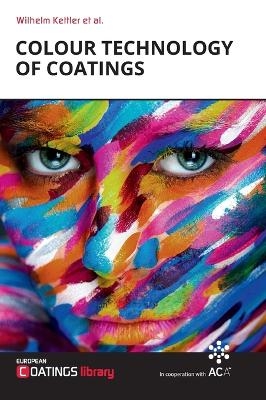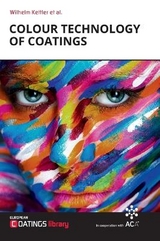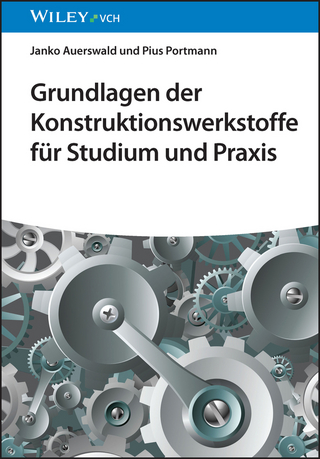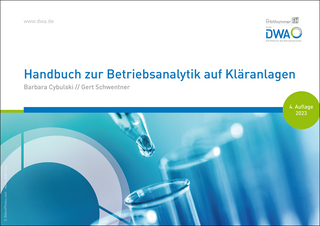Colour Technology of Coatings
Vincentz Network (Verlag)
978-3-86630-699-8 (ISBN)
Contents
I Fundamentals of colour perception
Stefan Gauss
1 Human colour vision
1.1 The human eye
1.1.1 Optical structure
1.1.2 Signal processing and special features
1.2 The photoreceptor cells in the human eye
1.2.1 Spectral sensitivity of the receptors
1.2.2 Visual defects
1.3 Colour perception
1.3.1 Chromophoric attributes
1.3.2 Colour constancy
2 Light as Electromagnetic Radiation
3 Colour mixing.
3.1 Additive colour mixing
3.2 Subtractive colour mixing
4 Interaction of light and matter
5 Standard illuminants and light sources
5.1 Standardilluminants
5.2 Light sources
6 Standard observer
7 CIE 31 system.
7.1 Calculation of tristimulus values
7.2 Chromaticity coordinates
8 CIELAB system
8.1 The L*, a*, b* coordinates
8.2 The L*, C*, h coordinates
8.3 Colour differences
8.4 Colour tolerances and MacAdam ellipses
9 Metamerism
9.1 Colour constancy
9.2 Metameric pairs
9.3 Special metameric index
II Colour measurement, colour measurement systems and visual colour assessment
1 Principles behind measuring coloured surfaces
Gerhard Rösler, translated by Manfred Binder
1.1 Analytical and visual characterisation of colour
1.1.1 Method A: Tristimulus colorimeter
1.1.2 Methods B and C: Spectrophotometer with polychromatic illumination
1.1.3 Method D: Spectrophotometer with monochromatic illumination
1.1.4 Method E: Bi-spectral measurement
1.1.5 Spectral measuring range, resolution and illumination
1.1.6 Spectrometers, monochromators and detectors
2 Measuring geometries
Gerhard Rösler, translated by Manfred Binder
2.1 Sphere geometries for reflectance measurements
2.2 Directional geometries for reflectance measurements
2.3 Measuring geometries for different sample types and sample properties
2.4 Recommended geometries for transmission measurement
2.5 Notes on choosing the right geometry
2.6 Multi-angle geometries
3 Measuring geometries for special effect pigments
Peter Gabel
3.1 Optical principles behind special effect pigments
3.2 Measuring geometries for metallic pigments
3.3 Measuring geometries for special effect pigments
3.4 New measuring geometries – applications for special effect pigments
3.4.1 New measuring geometries – new developments
4 Sample preparation
Gerhard Rösler, translated by Manfred Binder
5 Recommended colourimetric conditions
Gerhard Rösler, translated by Manfred Binder
5.1 Calibration of the colour-measuring instrument
5.2 Ambient conditions
5.3 Black calibration
5.4 White calibration
5.5 Calibration function
5.6 Control measurement
5.7 Storage of calibration standards
5.8 Laboratory report
6 Influence of the surface
Gerhard Rösler, translated by Manfred Binder
7 Special case: optical brighteners and fluorescence
Gerhard Rösler, translated by Manfred Binder
8 Sources of error in colour measurements
Stefan Gauss
8.1 Errors in sample preparation
8.2 Instrument error
8.3 Experimental error
9 Profiling of measuring instruments and colour management
Gerhard Rösler, translated by Manfred Binder
9.1 Commonly used colour standards
for profiling colour-measurement instruments
9.2 Set of colour standards for colour-measuring instruments
9.3 Instrument maker accuracy and profiling
10 Non-contact colour measurement
Gerhard Rösler, translated by Manfred Binder
III Visual colour assessment
Gerhard Rösler, translated by Manfred Binder
1 Colour perception and colour deficiency
2 Light booths
3 Visual colour assessment of samples with effect coatings
3.1 Method: sample modulation
3.2 Method: illumination modulation
3.3 Method: observer modulation
3.3.1 Assessment of special effect pigments by the method of observer modulation
3.4 Summary of visual assessment of effect-coated samples
IV Colour-order systems
Wilhelm Kettler
1 Introduction and definition
2 Psychometric scales
3 Colour scales
4 Colour notation systems
4.1 CIELAB, CIELUV, and DIN99
4.2 Munsell colour system
4.3 DIN colour system
4.4 NCS colour system
4.5 OSA-UCS colour system
4.6 RAL design system
5 Colour-naming systems and colour-card collections
5.1 RAL system
5.2 British Standards Institution (BSI)
5.3 Pantone colour system
6 Link between colour-order systems
7 Decisions
V Instrumental colour difference assessment
Wilhelm Kettler
1 Introduction
2 Geometric structure of colour difference models
3 Colour difference model CMC(kL : kC)
4 Colour difference model BFD(kL : kC)
5 Colour difference model CIE94
6 Colour difference model CIEDE2000
7 Colour space DIN99
8 Parametric effects
9 Comparative analyses of the performance of modern colour difference models
9.1 Normalisation
9.2 Lightness scale
9.3 Chroma and hue scales
9.4 Total colour difference
10 Appraisal of the current state of colour difference metric
11 Model extensions for goniochromatic colours
VI Definition and application of colour tolerances
Wilhelm Kettler
1 Tolerance and acceptance
1.1 Euclidean colour space
1.2 Non-Euclidean colour space
2 Psychophysical measurements
3 Visual colour assessment
4 Statistical threshold determination
5 An experiment to define colour tolerances
6 Significance of colour measurement results
6.1 Multivariate statistics
6.2 Statistics for 3-dimensional colour spaces
6.3 The scatter ellipsoid
7 Tolerances for solid colours: DIN 6175 P1Tolerances for gonioapparent colours: DIN 6175 P2
VII Pigment optics – physical processes
Uwe Hempelmann
1 Colour-generating processes
2 Reflection, refraction, diffraction, interference
3 Mie theory
4 Kubelka-Munk function for opaque layers
5 Saunderson correction: how surfaces influence
the outcome of reflectance measurements
6 Kubelka-Munk equation for transparent layers
7 Multi-flux theory
7.1 Criticism of the Kubelka-Munk model
7.2 Radiative transfer equation
VIII Practical applications
Uwe Hempelmann
1 Tinting strength
2 Hiding power
IX Measuring the texture of effect finishes
Sandra Weixel
1 Sparkle and graininess
1.1 Visual evaluation of sparkle and graininess
1.2 Instrumental measurement of sparkle and graininess
1.2.1 Sparkle measurement under direct illumination
1.2.2 Graininess measurement under diffuse illumination
2 Sparkle and graininess applications
2.1 Influence of flake size on sparkle and graininess
2.2 Influence of flake orientation on total colour impression
3 Conclusions
X Characterisation of pigments
1 Inorganic pigments – characterisation
Rainer Henning
1.1 White (P.W. 6) and black (P.Bl. 7)
1.2 Important inorganic colouredpigments
1.2.1 Inorganic yellow and red pigments
1.2.2 Inorganic green and blue pigments
2 Organic pigments – characterisation
Rainer Henning
2.1 Red pigments
2.2 Orange pigments
2.3 Yellow pigments
2.5 Blue organic pigments
2.6 Violet organic pigments
3 Characterisation of aluminium pigments
Hans-Jörg Kremitzl
3.1 The metallic effect and its cause
3.1.1 Leafing and non-leafing properties
3.1.2 Particle-size and diameter
3.1.3 Particle shape, thickness, and topography
3.1.4 Orientation of pigments in the paint film
3.2 Comparison of various pigment grades
3.3 Chemical and mechanical properties
4 Characterisation of pearlescent pigments and special effect pigments
Peter Gabel and Gerhard Pfaff
4.1 Manufacture, properties and types of special effect pigments
4.1.1 Metal oxide mica pigments
4.1.1.1 Titanium dioxide mica pigments
4.1.1.2 Titanium dioxide mica pigments with multi-layers
4.1.1.3 Iron(III) oxide mica pigments
4.1.1.4 Combination pigments based on metal oxide and mica
4.1.2 Effect pigments based on alumina flakes
4.1.3 Metal oxide pigments based on borosilicate flakes
4.1.4 Metal oxide pigments based on silica flakes
4.1.5 Metal oxide pigments based on iron oxide flakes
4.1.6 Multi-layer pigments with a Fabry-Perot structure
4.1.7 Effect pigments based on liquid-crystal polymers (cholesteric effect pigments)
4.1.8 Structured effect pigments
XI Recipe prediction
Uwe Hempelmann
1 Recipe prediction for solid colours
2 Calibration of colorants
3 Computer-aided correction of colour recipes
4 Practical colour-recipe prediction of gonioapparent colours
4.1 Topology of effect pigments in surface coatings
4.2 The limitations of colour recipe prediction
5 The profitability of colour recipe calculation
5.1 Review
5.2 General savings potential afforded by colour recipe calculation
5.2.1 Swift feasibility analysis
5.2.2 Low-cost metamerism-free recipes
5.2.3 Accurate corrections in production
5.2.4 Fewer complaints
5.2.5 Computer algorithms for saving costs in specific applications
5.2.6 Profitability analysis – summary
6 Guidelines for formulating and matching object colours
6.1 Rules for mixing pigments
6.2 Solid colours
6.3 Gonioapparent colours
6.4 Hiding power and pigmentation level
7 Recipe dosability
8 Structure of colour mixing systems
8.1 Introduction
8.2 Alternative methods of paint production
8.2.1 Production of OEM paint material
8.2.2 Advantages of colour mixing systems
8.2.3 Paint mixing systems
8.2.4 Universal mixing systems
8.3 Coloristic demands on colour mixing systems
9 Optimisation of colour mixing systems
9.1 CIELAB colour maps of colour mixing systems
9.2 Colouring characteristics of pigments
10 Colour gamuts and the limits of colour matching
XII Microscopic analysis of effect pigments
Gerhard Wilker
1 Matching of effect colour shades
1.1 Application of light microscopy
1.2 Accessories for the light microscope
2 Effect pigments
2.1 Overview
2.2 Aluminium flakes
2.3 Mica-based pearlescent pigments
2.4 Miscellaneous effect pigments
2.4.1 Effect pigments based on aluminium coated with iron oxide
2.4.2 Effect pigments based on aluminium oxide platelets
2.4.3 Effect pigments based on silicon dioxide platelets
2.4.4 Optimised pearlescent pigments with titanium dioxide coating
2.4.5 Multilayer pigments with Fabry-Perot structure (OVIP)
2.4.6 Bismuth oxychloride
3 Application examples
3.1 Orientation of effect pigments in paint films
3.2 Mixtures of effect pigments
3.3 Tinted clearcoat
3.4 Effect paints in combination with light-scattering pigments
3.5 Use of polarised light
4 Systematic approach to colour-matching effect shades
4.1 Factors affecting the matching of effect shades
4.2 Colour-matching system and systematic approach
4.3 Preparation of calibration panels
4.4 Options and application of the colour-matching system
4.5 Colour-matching procedure
5 Some useful hints for colour-matching effect paints
Authors
Index
Like many other textbooks, this one has its origins in the classroom and is the culmination of more than 10 years’ experience of teaching courses on colorimetry to engineers and technicians from various branches of industry. The VDMI, the VdL and the FPL asked various experts at pigments, paints, and instrument makers in 2000 to design various training modules for colourists working on industrial, plastics, paint, and print applications of colour. The objective was to provide a technically correct and up-to-date introduction to those many aspects of colour and colour applications in industry. The target group was engineers deeply involved in colour applications in various industrial sectors. The first set of training modules was offered in 2001. Until retiring in 2014, Dr. Tasso Bäurle successfully steered the ship for almost 14 years, taking charge of the training modules. He continually refined and modified the underlying concept to meet the demands of the participants and participating industries. The latest version comprises just two modules covering elementary concepts of colorimetry and in-depth insights in colorimetry. Although the main focus is on paint applications, all the methods presented can be readily adapted to colour applications in other industries. The main purpose of this book is to provide a comprehensive survey of relevant industrial colour applications and numerous concepts of physical and physiological pigment optics in order that a written record may be preserved of the specialist knowledge of all the lecturers involved in the coloristic training course. The colour problems discussed in this book include optics and chemistry of solid-colour and effect pigments, colourant formulation, optical microscopy of effect colour shades for pigment identification, methods of elementary and advanced colorimetry, measurement and visual assessment of solid and effect colour shades, colour tolerances and acceptability, and colour-order systems. Compared to the first German edition, this English edition contains a further chapter devoted to the newly emerging area of visual texture assessment of effect colour shades. Although technology for measuring visible texture is already available on the market, no mathematically rigorous definition of texture parameters and their dimensionality has been formulated so far that would be accepted throughout the colour community. However, a combination of multidimensional texture and colour information is the appropriate paradigm to adopt for proper physical characterisation of the visual appearance of effect colour shades. The contents of this book are a mix of objective detachment on one hand and a detailed first-hand knowledge and practical relevance on the other. The mathematics throughout the book have been kept to a minimum, even though the technical treatment of colour problems is being driven more and more by mathematical models. Many references at the ends of chapters cite original papers. The reader is encouraged to consult these as further sources of information and to supplement the physical and physiological basics presented in this book with more general mathematics and rigor, as necessary. As this English edition of the training course for colourists was being prepared, one of the authors, Dr. Gerhard Rösler, unexpectedly passed away in December 2012. I believe that Gerhard would be pleased with the expanded English edition of our joint project. Wilhelm H. Kettler Wülfrath, Germany, January 2016
Like many other textbooks, this one has its origins in the classroom and is the culmination of more than 10 years' experience of teaching courses on colorimetry to engineers and technicians from various branches of industry.The VDMI, the VdL and the FPL asked various experts at pigments, paints, and instrument makers in 2000 to design various training modules for colourists working on industrial, plastics, paint, and print applications of colour.The objective was to provide a technically correct and up-to-date introduction to those many aspects of colour and colour applications in industry. The target group was engineers deeply involved in colour applications in various industrial sectors. The first set of training modules was offered in 2001. Until retiring in 2014, Dr. Tasso Bäurle successfully steered the ship for almost 14 years, taking charge of the training modules. He continually refined and modified the underlying concept to meet the demands of the participants and participating industries. The latest version comprises just two modules covering elementary concepts of colorimetry and in-depth insights in colorimetry. Although the main focus is on paint applications, all the methods presented can be readily adapted to colour applications in other industries.The main purpose of this book is to provide a comprehensive survey of relevant industrial colour applications and numerous concepts of physical and physiological pigment optics in order that a written record may be preserved of the specialist knowledge of all the lecturers involved in the coloristic training course. The colour problems discussed in this book include optics and chemistry of solid-colour and effect pigments, colourant formulation, optical microscopy of effect colour shades for pigment identification, methods of elementary and advanced colorimetry, measurement and visual assessment of solid and effect colour shades, colour tolerances and acceptability, and colour-order systems. Compared to the first German edition, this English edition contains a further chapter devoted to the newly emerging area of visual texture assessment of effect colour shades. Although technology for measuring visible texture is already available on the market, no mathematically rigorous definition of texture parameters and their dimensionality has been formulated so far that would be accepted throughout the colour community. However, a combination of multidimensional texture and colour information is the appropriate paradigm to adopt for proper physical characterisation of the visual appearance of effect colour shades. The contents of this book are a mix of objective detachment on one hand and a detailed first-hand knowledge and practical relevance on the other.The mathematics throughout the book have been kept to a minimum, even though the technical treatment of colour problems is being driven more and more by mathematical models. Many references at the ends of chapters cite original papers. The reader is encouraged to consult these as further sources of information and to supplement the physical and physiological basics presented in this book with more general mathematics and rigor, as necessary.As this English edition of the training course for colourists was being prepared, one of the authors, Dr. Gerhard Rösler, unexpectedly passed away in December 2012. I believe that Gerhard would be pleased with the expanded English edition of our joint project.Wilhelm H. KettlerWülfrath, Germany, January 2016
| Erscheinungsdatum | 05.04.2016 |
|---|---|
| Reihe/Serie | EUROPEAN COATINGS library |
| Zusatzinfo | Zahlreiche farbige Abbildungen, Tabellen und Formeln |
| Verlagsort | Hannover |
| Sprache | englisch |
| Maße | 165 x 260 mm |
| Gewicht | 893 g |
| Einbandart | gebunden |
| Themenwelt | Naturwissenschaften ► Chemie |
| Schlagworte | Beschichtung • Characterisation of pigments • Chemie • Coatings • Colour measurement, • Colour-order systems • colour perception • Colour tolerances • Pigment optics |
| ISBN-10 | 3-86630-699-7 / 3866306997 |
| ISBN-13 | 978-3-86630-699-8 / 9783866306998 |
| Zustand | Neuware |
| Haben Sie eine Frage zum Produkt? |
aus dem Bereich




